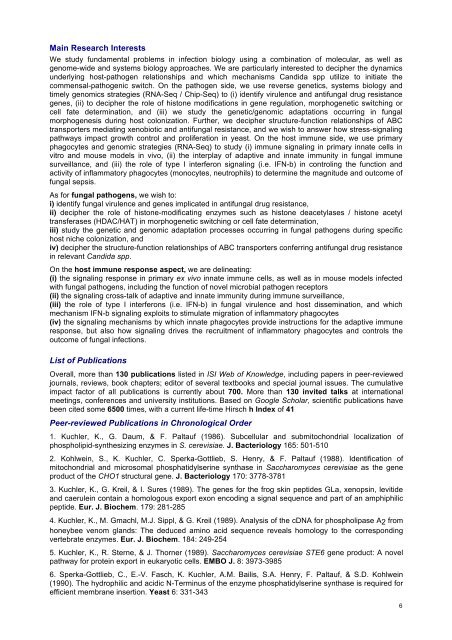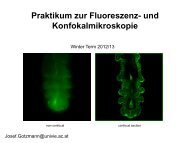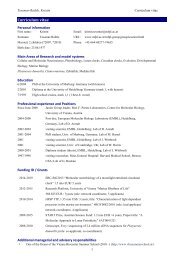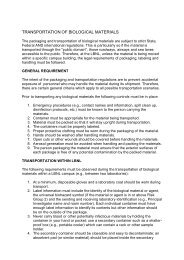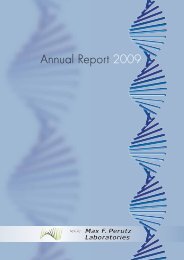Download CV - Max F. Perutz Laboratories
Download CV - Max F. Perutz Laboratories
Download CV - Max F. Perutz Laboratories
- No tags were found...
You also want an ePaper? Increase the reach of your titles
YUMPU automatically turns print PDFs into web optimized ePapers that Google loves.
Main Research InterestsWe study fundamental problems in infection biology using a combination of molecular, as well asgenome-wide and systems biology approaches. We are particularly interested to decipher the dynamicsunderlying host-pathogen relationships and which mechanisms Candida spp utilize to initiate thecommensal-pathogenic switch. On the pathogen side, we use reverse genetics, systems biology andtimely genomics strategies (RNA-Seq / Chip-Seq) to (i) identify virulence and antifungal drug resistancegenes, (ii) to decipher the role of histone modifications in gene regulation, morphogenetic switching orcell fate determination, and (iii) we study the genetic/genomic adaptations occurring in fungalmorphogenesis during host colonization. Further, we decipher structure-function relationships of ABCtransporters mediating xenobiotic and antifungal resistance, and we wish to answer how stress-signalingpathways impact growth control and proliferation in yeast. On the host immune side, we use primaryphagocytes and genomic strategies (RNA-Seq) to study (i) immune signaling in primary innate cells invitro and mouse models in vivo, (ii) the interplay of adaptive and innate immunity in fungal immunesurveillance, and (iii) the role of type I interferon signaling (i.e. IFN-b) in controling the function andactivity of inflammatory phagocytes (monocytes, neutrophils) to determine the magnitude and outcome offungal sepsis.As for fungal pathogens, we wish to:i) identify fungal virulence and genes implicated in antifungal drug resistance,ii) decipher the role of histone-modificating enzymes such as histone deacetylases / histone acetyltransferases (HDAC/HAT) in morphogenetic switching or cell fate determination,iii) study the genetic and genomic adaptation processes occurring in fungal pathogens during specifichost niche colonization, andiv) decipher the structure-function relationships of ABC transporters conferring antifungal drug resistancein relevant Candida spp.On the host immune response aspect, we are delineating:(i) the signaling response in primary ex vivo innate immune cells, as well as in mouse models infectedwith fungal pathogens, including the function of novel microbial pathogen receptors(ii) the signaling cross-talk of adaptive and innate immunity during immune surveillance,(iii) the role of type I interferons (i.e. IFN-b) in fungal virulence and host dissemination, and whichmechanism IFN-b signaling exploits to stimulate migration of inflammatory phagocytes(iv) the signaling mechanisms by which innate phagocytes provide instructions for the adaptive immuneresponse, but also how signaling drives the recruitment of inflammatory phagocytes and controls theoutcome of fungal infections.List of PublicationsOverall, more than 130 publications listed in ISI Web of Knowledge, including papers in peer-reviewedjournals, reviews, book chapters; editor of several textbooks and special journal issues. The cumulativeimpact factor of all publications is currently about 700. More than 130 invited talks at internationalmeetings, conferences and university institutions. Based on Google Scholar, scientific publications havebeen cited some 6500 times, with a current life-time Hirsch h Index of 41Peer-reviewed Publications in Chronological Order1. Kuchler, K., G. Daum, & F. Paltauf (1986). Subcellular and submitochondrial localization ofphospholipid-synthesizing enzymes in S. cerevisiae. J. Bacteriology 165: 501-5102. Kohlwein, S., K. Kuchler, C. Sperka-Gottlieb, S. Henry, & F. Paltauf (1988). Identification ofmitochondrial and microsomal phosphatidylserine synthase in Saccharomyces cerevisiae as the geneproduct of the CHO1 structural gene. J. Bacteriology 170: 3778-37813. Kuchler, K., G. Kreil, & I. Sures (1989). The genes for the frog skin peptides GLa, xenopsin, levitideand caerulein contain a homologous export exon encoding a signal sequence and part of an amphiphilicpeptide. Eur. J. Biochem. 179: 281-2854. Kuchler, K., M. Gmachl, M.J. Sippl, & G. Kreil (1989). Analysis of the cDNA for phospholipase A2 fromhoneybee venom glands: The deduced amino acid sequence reveals homology to the correspondingvertebrate enzymes. Eur. J. Biochem. 184: 249-2545. Kuchler, K., R. Sterne, & J. Thorner (1989). Saccharomyces cerevisiae STE6 gene product: A novelpathway for protein export in eukaryotic cells. EMBO J. 8: 3973-39856. Sperka-Gottlieb, C., E.-V. Fasch, K. Kuchler, A.M. Bailis, S.A. Henry, F. Paltauf, & S.D. Kohlwein(1990). The hydrophilic and acidic N-Terminus of the enzyme phosphatidylserine synthase is required forefficient membrane insertion. Yeast 6: 331-3436


